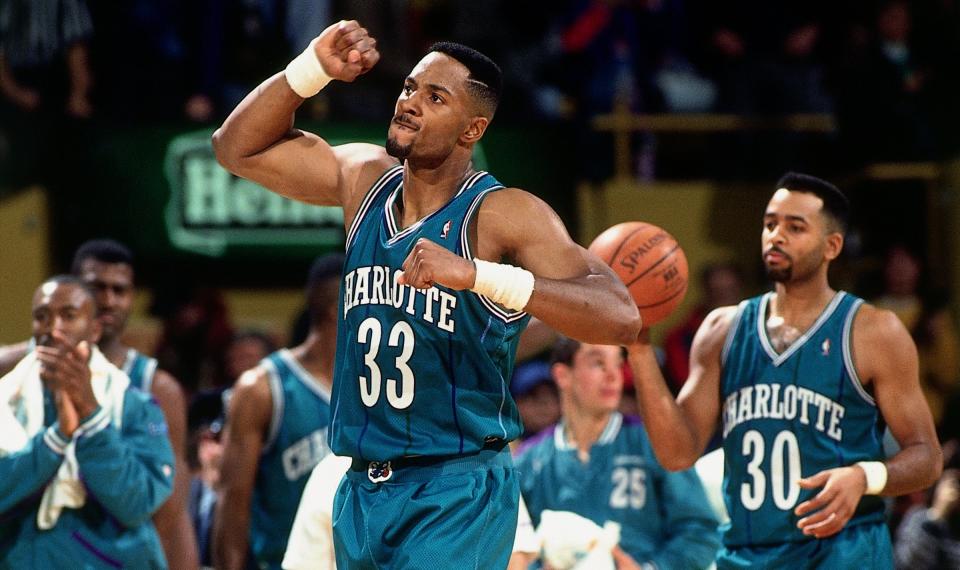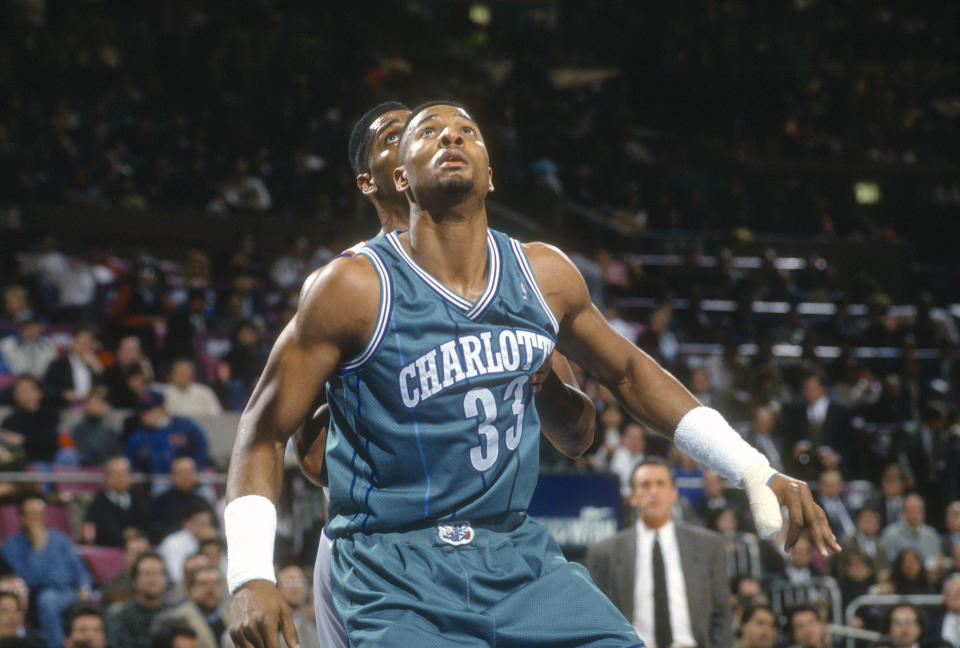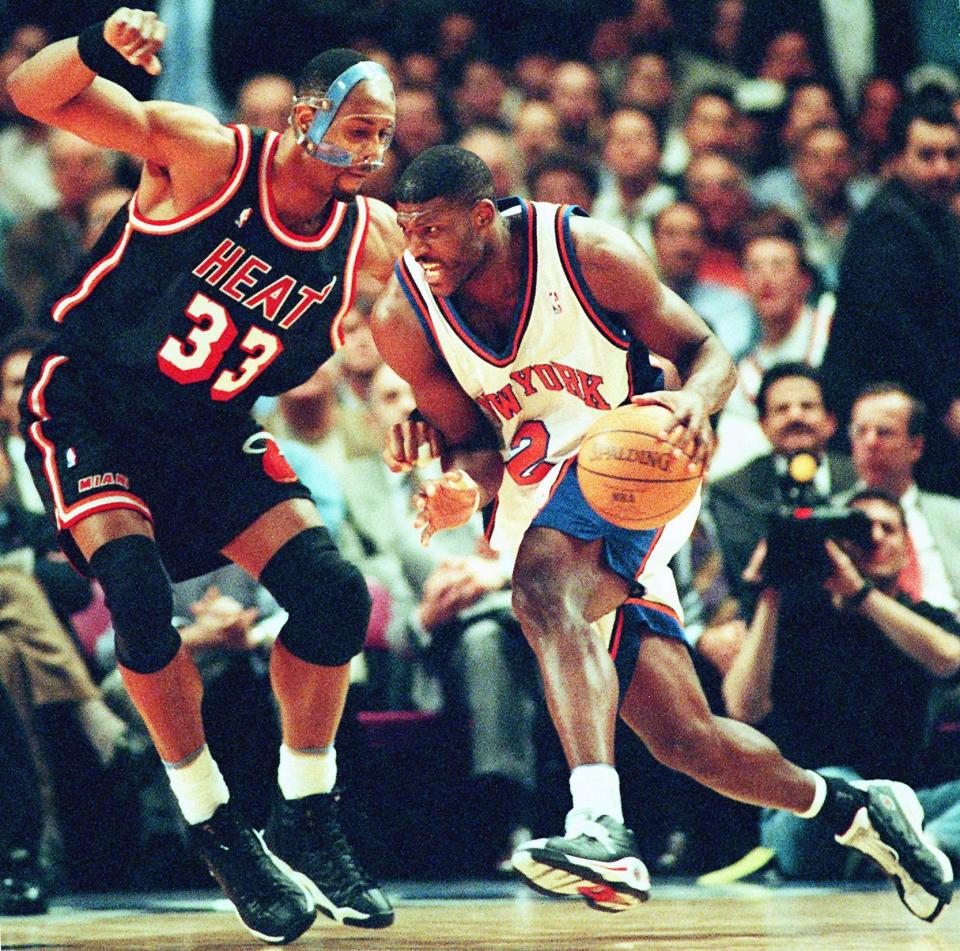Sunk History: Alonzo Mourning's buzzer-beater sinks Celtics, aka when the Hornets mattered
In the midst of the coronavirus pandemic, with the NBA’s future still so uncertain, we look again to the past, polishing up our Dunk History series — with a twist. If you are in need of a momentary distraction from the state of an increasingly isolated world, remember with us some of the most electrifying baskets and improbable buckets in the game’s history, from buzzer-beaters to circus shots. This is Sunk History.
Today, we revisit the time rookie Alonzo Mourning put a fledgling franchise on the map.
[Dunk History, collected: Our series on the most scintillating slams of yesteryear]
Raise your hand if you remember when the Charlotte Hornets were fun.
It’s hard in 2020 to imagine the NBA franchise as anything but a pillar of mediocrity, a beacon of mismanagement and a how-to guide for blowing draft pick after draft pick.
Frank Kaminsky instead of Devin Booker, anyone?
But if you were paying attention to the Hornets in the early 1990s, you were watching a franchise filled with hope and backed by a ravenous fanbase basking in its first taste of the NBA.

The rise and fervor of the Charlotte Hornets
The Hornets came into existence in 1988 and quickly endeared themselves to a region that had long held a love affair with hoops. Armed with the hottest uniform in sports and savvy expansion drafting that landed sharpshooter Dell Curry and fan favorite Muggsy Bogues, the Hornets had no trouble filling up the 24,000-seat Charlotte Coliseum on a nightly basis.
It didn’t matter that they were bad in the early days. They were supposed to be. This was an expansion team. And three straight seasons of failing to win more than 26 games paid off in lottery riches.
The Hornets hit the jackpot in 1991, landing the No. 1 pick in the draft and the grand prize that was UNLV superstar Larry Johnson, an explosive power forward with the grace of a shooting guard and the build of a linebacker. Think Zion Williamson for the early ’90s set.
Future of the NBA
The Hornets failed to make the playoffs in Johnson’s Rookie of the Year campaign, finding themselves in the lottery once again. This time, they didn’t quite hit the jackpot, as the No. 1 pick and the right to select Shaquille O’Neal went to a fellow expansion franchise, the Orlando Magic. But the consolation prize was still sweet. The No. 2 pick and the rights to Georgetown center Alonzo Mourning went to the Hornets.
Mourning was an immediate star in Charlotte, averaging 21 points, 10.3 rebounds and 3.5 blocks per game as a rookie. With Johnson making his first All-Star team that same season, the Hornets had officially arrived, built around the most exciting young duo in the NBA.
Only when Penny Hardaway joined O’Neal in Orlando the following year would a young NBA tandem with as much promise rival Charlotte’s frontline.

Fading Celtics icons are Hornets’ first playoff test
The Hornets would follow through on that promise in 1993, improving by 13 games over the previous season to finish 44-38 and earn the No. 5 seed in the Eastern Conference playoffs.
They won nine of their final 12 games to secure the franchise’s first playoff spot and the right to face the fabled Boston Celtics.
Gone was Larry Bird, who had retired the season before. Kevin McHale and Robert Parish remained from Boston’s run of three championships during the 1980s. But the new focus on Boston’s offense was captain Reggie Lewis, a 27-year-old All-Star shooting guard who led the team with 20.8 points per game.
Tragedy looms over Celtics
Boston won Game 1 at home, but the result was overshadowed by the then-mysterious collapse of Lewis. Lewis fell to the floor without contact in the first half, only to return briefly in the second half before leaving the court again for good. It was a preamble to a tragedy.
Lewis was hospitalized for 11 days after his collapse as doctors diagnosed him with a heart condition. Three months later, Lewis died after he collapsed again while taking shots at the Celtics training facility.
The series carried on with Lewis still hospitalized and did so in dramatic fashion. With Dee Brown replacing Lewis in Boston’s starting lineup, the Hornets stole Game 2 in Boston, 99-98, behind a 23-point effort from Johnson and Mourning’s 18 points, 14 rebounds and six blocks.
Johnson, Mourning feast
Charlotte’s first home playoff game was a rousing success, as Johnson exploded for 29 points and 11 rebounds while Curry caught fire off the bench for 27 points in a 119-89 Hornets win. It set Charlotte up for a chance to clinch its first playoff series victory at home.
For a while, Game 4 started to look a lot like Game 3. Charlotte raced out to a 59-46 halftime lead that it extended to as much as 19 points in the third quarter. The Hornets looked ready to advance in blowout fashion.
But the Celtics mounted a fourth-quarter rally, outscoring the Hornets, 33-16, taking a 103-102 lead — their first of the night — with 42.7 seconds remaining on a Sherman Douglas layup.
Charlotte eventually found itself with the ball on the frontcourt baseline, trailing by the same score with 3.3 seconds remaining. The scene set up the biggest shot in franchise history.
Mourning’s massive rookie moment
Curry was charged with the inbounds play as the Hornets faced a chance to end the series. Mourning broke free from a scrum of players on the left wing, where Curry found him with a pass over the Boston defense.
Mourning took one dribble to the right and launched a jumper from the top of the key. He immediately fell to his back as the ball sank through the net and the clock ticked down to zero.
Mourning’s teammates immediately piled on in celebration as it appeared that he’d ended the game and the series with the game-winner. Cheerleaders joined the celebration as photographers swarmed the court to document the dramatic moment.
It wasn’t over quite yet. Officials checked the video and put 0.4 seconds back on the clock. But Boston’s last-second desperation shot missed the mark, and the Hornets secured the first playoff series victory of the league’s four recent expansion franchises that included the Magic, Miami Heat and Minnesota Timberwolves.
They would go on to lose to Patrick Ewing’s New York Knicks in the second round. But the youngest team in the playoffs had made its mark and was poised to begin a long run of success five years into the franchise’s existence.
Or so it seemed.
How did this all go wrong?
That offseason, Johnson, 24, would go on to sign a record-breaking 12-year, $84 million contract that was at the time the richest in the NBA. He also suffered a herniated disc in a charity game that summer that signaled the demise of what had looked like a Hall of Fame career.
Back problems lingered for Johnson, who played in just 51 games the following season while his averages of 22.1 points and 10.5 rebounds fell to 16.4 and 8.8. Gone was the explosion that led to Grandmama fame. Johnson retooled his game as a perimeter player, but his back continued to hamper him for the remainder of a career largely served as a role player.
Hornets core dismantled
Meanwhile, contract talks between Mourning and owner George Shinn became contentious. Mourning wouldn’t get his LJ deal, and the Hornets traded Mourning to the rival Miami Heat in 1995 after three seasons and two All-Star games in Charlotte. He was 25 years old and embarking on a Hall of Fame career.
The Hornets traded Johnson to the Knicks the next season. All of a sudden, the promise and energy of Mourning’s game-winner to defeat the Celtics had dissipated.

With Glen Rice as their core player during the late 1990s, the Hornets still found success, making the playoffs as the No. 3 seed in 1997 and 1998, and advancing to the second round in 1998.
But the magic was gone.
George Shinn: Hero to goat (with a little g)
Fan support began to wane as the city grew to loathe Shinn, who was embroiled in an alleged sexual assault scandal in 1997 and later demanded tax-payer money for a new arena. Shinn, once loved in Charlotte for bringing the NBA to town, was reviled by the time he took the team to New Orleans in 2002.
An arena that led the league in attendance from 1988 to 1996 ranked dead last in 2002. Shinn had dismantled the core of a team that had generated so much hope, found himself in an off-court scandal and then demanded tax dollars to replace a 14-year-old arena. Turning down home-state hero Michael Jordan — who sought an ownership stake in the franchise after his 1998 retirement from the Chicago Bulls — didn’t help his cause.
The love affair was over, and in ugly fashion.
Hornets haven’t mattered since
The NBA returned to Charlotte in 2004 with the Bobcats, which eventually reclaimed the old Hornets branding. But the magic has yet to return. Charlotte has seen a grand total of three playoff victories since the NBA returned to the city.
And 27 years later, a buzzer-beater to advance to the second round of the playoffs remains the pinnacle moment of a forlorn franchise.
More Sunk History:
• Michael Jordan puts it all on the line and wins big with ‘The Shot’
• When Steph Curry redefined what it meant to shoot from deep
• Before Paul Pierce was the Finals MVP, he was the trash-talking Truth

